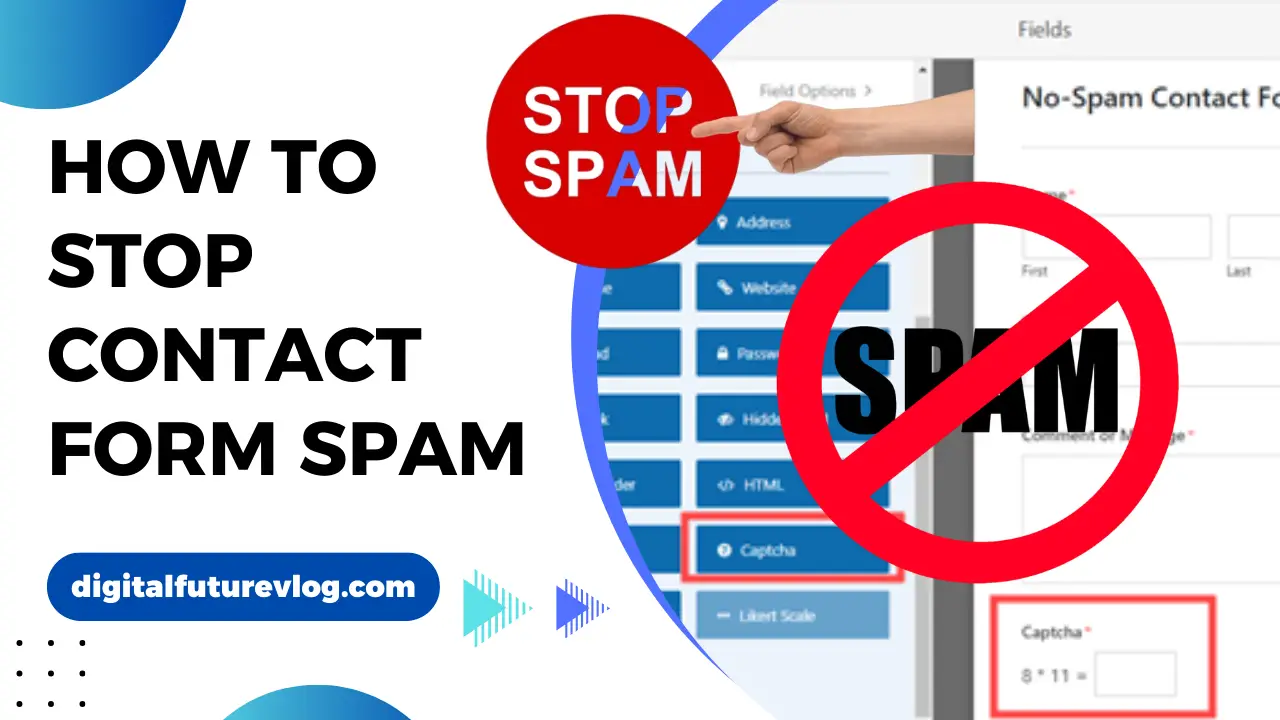In this comprehensive guide, we’ll explain what contact form spam is, why it happens, and most importantly, how to stop it using effective tools and techniques. Whether you’re on WordPress, a static site, or a page builder like Wix, this guide has you covered.
What Is Contact Form Spam?
Contact form spam is unwanted or multipal message submitted through a form on your website. It can be harmless (like nonsense text), annoying (like fake job offers), or harmful (like phishing links or scams).
Why it’s a problem:
Wastes your time sorting messages
Buries real customer inquiries
May put a strain on your server if thousands of entries are received.
May pose a security risk
Since they are typically automated, they could be a security concern and overflow your inbox with irrelevant emails.
How to Stop Contact Form Spam (Step-by-Step)
Let us go over 10 effective strategies for preventing spam on the contact form on your website. For best results, each step can be utilized separately or in combination.
1. Use CAPTCHA or reCAPTCHA
Your form will be submitted by a real person if you include a CAPTCHA.
Options Include:
Checkbox: “I’m not a robot”
reCAPTCHA v3 (Behavior scoring, no user input needed)
Invisible reCAPTCHA (Triggers only on suspicious behavior)
Pros:
High bot-blocking power
Easy to integrate with most platforms
Cons:
Slight friction for users
Some users dislike image puzzles
Tip: With just a few clicks, WordPress plugins such as WPForms or Contact Form 7 may implement reCAPTCHA.
2. Use Honeypot Fields
A hidden field on your form is called a honeypot. Bots frequently fill it in, but humans cannot see it. It automatically rejects the message if that field is filled up.
How it Works:
Your backend then checks if “website” is filled in. If yes—blocked!
Pros:
No interaction required from users
Very effective for basic bots
Cons:
Smart bots may bypass it
Requires some coding or plugin support
3. Use Email Address Validation
Most bots use fake or malformed email addresses. Validating emails before form submission can eliminate a chunk of spam.
Techniques:
HTML5 validation:
<input type="email">Regex-based checks (e.g.,
/^[^\s@]+@[^\s@]+\.[^\s@]+$/)Email confirmation fields
Bonus Tip: Before continuing, confirm the sender’s identity via a double opt-in procedure.
4. Limit Submissions by IP Address
If you’re getting hit repeatedly from one IP, rate-limiting or blocking that IP can help.
Tools:
Wordfence (WordPress)
Cloudflare (Rate-limiting rules)
Server firewall configuration
Caution:
Do not go overboard because some actual users may accidentally submit the form more than once.
5. Add Custom Questions
Asking a simple question can stump spam bots that don’t know how to interpret human language.
Example:
“What color is the sky on a clear day?” (Answer: blue)
Good Questions:
Simple math (2 + 2 = ?)
Basic facts
Human logic questions
Avoid:
Cultural references
Ambiguous answers
Questions that confuse users
6. Use a Secure Form Plugin
Not all form builders are created equal. Some come with built-in anti-spam tools like honeypots, CAPTCHA, and keyword filters.
Top Plugins:
WPForms (Anti-spam token + honeypot)
Gravity Forms (Akismet + reCAPTCHA)
Contact Form 7 (Supports reCAPTCHA and spam filters)
These tools offer smarter form controls with minimal coding.
7. Block High-Risk Countries (Optional)
Blocking traffic from nations you do not serve could be helpful if the majority of your spam comes from such areas.
Tools:
Cloudflare Firewall Rules
Geo-blocking plugins for WordPress
Server-side access control
Use Wisely:
Geo-blocking can affect legitimate users and clients. Only use this if you’re sure your audience is local.
8. Use Akismet for WordPress
A spam filter service called Akismet compares contributions from contact forms to its global database of known spam.
Works With:
Contact Form 7
Jetpack
Gravity Forms
You’ll need a free API key for personal use or a paid plan for commercial sites.
9. Filter by Keywords or Links
Spammers often use similar phrases like:
“Buy now”
“Best SEO services”
“Work from home”
Suspicious domains like
.ru,.xyz,.click
You can block these phrases using:
Plugin keyword filters
Server-side scripting
Regex-based content screening
Pro Tip: Regularly review your spam submissions to update your keyword blacklist.
10. Use a Web Application Firewall (WAF)
Before hostile bots even get to your form, a WAF defends your website.
Top Options:
Cloudflare (Free plan includes basic bot protection)
Sucuri (Premium WAF and malware scanning)
ModSecurity (Apache-based, server-level)
Not only does a WAF stop spam—it also improves overall security.
Still Getting Spam?
Every system has flaws. Unpredictably, some bots might still get through.
What to do:
Review your settings
Add more filters (e.g., CAPTCHA + honeypot combo)
Monitor IPs, keywords, and behavior trends
Spam evolves—so should your defenses.
TLDR: Spam Prevention Checklist
Here is a brief summary of the most effective strategies for preventing contact form spam:
| Method | Description |
|---|---|
| CAPTCHA/reCAPTCHA | Blocks bots using human verification |
| Honeypot Fields | Invisible traps for bots |
| Email Validation | Blocks malformed email addresses |
| IP Rate Limiting | Prevents abuse from repeated sources |
| Custom Questions | Filters basic bots |
| Anti-Spam Plugins | Built-in protection in form builders |
| Geo-Blocking | Limits access from spam-prone regions |
| Akismet | AI-powered spam detection for WordPress |
| Keyword Filters | Blocks messages with common spam phrases |
| Web Firewall | Stops spam before it hits your server |
Making ensuring that actual users can still easily contact you is just as vital as preventing spam. Avoid taking too many steps for verification. Prioritize using invisible safeguards (such as reCAPTCHA v3 and honeypots) and only add friction when necessary.
By combining these techniques, you can secure your contact form without frustrating your users—and finally enjoy a spam-free inbox.

